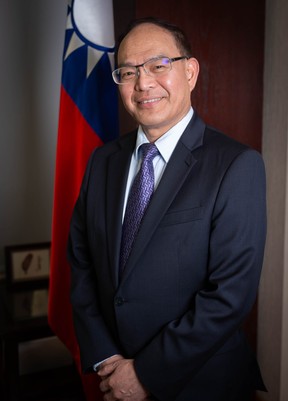As Canada's relationship with China deteriorates, ties to Taiwan grow closer
From Canadian warships transiting the Taiwan Strait to the House of Commons unanimously rejecting China's interpretation of their sovereignty, Ottawa and Taipei have never been closer

Article content
OTTAWA — Among the first things you notice upon entering Taiwan’s de facto O’Connor St. embassy in downtown Ottawa is the conspicuous lack of the word “Taiwan.”
The large letters above the service desks in the embassy’s foyer simply say, “Taipei Economic and Cultural Office in Canada.”
Conversely, Canada’s diplomatic presence in Taiwan’s capital is the “Canadian Trade Office in Taipei,” as Canada’s official policy dictates no formal diplomatic relations with the tiny nation.
As well, the business card for Harry Tseng — Taiwan’s ambassador to Canada — simply lists him as a “representative” rather than a diplomat.
“Anyone going to Taiwan, you don’t get a visa from the Chinese embassy, you get it from my office,” Tseng told The Toronto Sun during a sit-down interview.
“That’s all proof that we are de facto. De facto independence is not de jure (being officially recognized by Canada).”
As Canada’s relationship with China grows chillier by the day, its ties with Taiwan grow closer.
With its total north-to-south length roughly equal to the distance between Toronto and Ottawa, 24 million people call the tiny, 36,000-square-kilometre nation home.
And as more nations stand up to China’s aggression, they’re coming to appreciate — and rely upon — Taiwan’s unique role in the world.
THE ‘ONE CHINA’ POLICY IN ACTION
China’s influence over Taiwan is everywhere.
You won’t find athletes from Taiwan in the Olympics or other world sporting events — instead, they compete under the deliberately nebulous term “Chinese Taipei.”
This is thanks to the One China policy — adopted by nations seeking to maintain formal relations with the People’s Republic of China.
Recommended video
While the history is somewhat complex, it centres around the decades-long Chinese civil war which saw the Chinese Community Party emerge victorious, forcing Chiang Kai-shek and the defeated Republic of China government to flee to Taiwan in 1949.
Despite their democratically-elected government, currency, passports and international diplomatic corps, Taiwan — which still uses “Republic of China” as its official name — exists in a diplomatic “no-man’s land.”
Nations that wish diplomatic ties with the People’s Republic of China are — at Beijing’s behest — not to officially recognize Taiwanese sovereignty, and accept that the PRC is the only “China” in the region.
Canada’s trade with Taiwan, our 15th largest trading partner, is counted in the billions of dollars, with Global Affairs Canada maintaining “unofficial but valuable economic, cultural and people-to-people ties” with Taiwan, despite Canada’s own “One China policy.”
In 1971, UN Resolution 2758 recognized the PRC as the “only legitimate representative of China to the United Nations,” a move that saw Taiwan kicked out of the United Nations.
That resolution also ended Taiwan’s participation in various international organizations, including the World Health Organization, which, at China’s behest, uninvited Taiwan from its annual assembly in May. That proved one step too far for most Western democracies.
“We were forced out of the UN because of that resolution, and because of our absence, we have no voice in the UN,” Tseng said.
“Whatever China said was taken at face value by all of the member states, including their distorted interpretation of this resolution.”
Beijing is also using its interpretation of Resolution 2758 to legitimize their escalating aggression in and around the Taiwan Strait, the body of water separating the two nations between the East and South China Seas.

But the PRC’s interpretation is being challenged by an increasing number of Western powers — including Canada. On Nov. 6, the government adopted a motion in the House of Commons which challenges China’s position on Taiwan’s sovereignty.
“I think it’s very significant to Taiwan,” Tseng said of Canada’s motion, describing the adoption of Resolution 2758 as a “watershed moment” for Taiwan.
The United States made their own statement on the resolution earlier this year, as did the European Parliament.
Canada also made a bold statement last month when the HMCS Vancouver transited the Taiwan Strait as part of larger, multinational efforts to maintain freedom of international navigation through the disputed waters.
“The PRC doesn’t see the Taiwan Strait as international waters,” Tseng said, explaining that while China doesn’t claim the strait as it own territory, Beijing views the waterway as part of its exclusive economic zone (EEZ) under maritime law.
“They don’t say it’s their territory, but they say it’s not international waters, either.”
THE CONFLICT MOVES ONLINE
China’s beef with Taiwan has evolved over the years, with the sabre-rattling moving online following the advent of the information age.
With the Communications Security Establishment (CSE) last month describing China as “the most comprehensive cybersecurity threat facing Canada today,” there is much Taiwan can teach Canada when it comes to dealing with Chinese aggression online — as evidenced by the “cyber-attache” Canada recently dispatched to their embassy in Taipei.
“It is recognizing the importance of cyber-cooperation,” Tseng said.
“(Canada) only has about six or seven cyber-attaches in the Indo-Pacific countries, and Taiwan was chosen.”
Taiwan is a reliable target for Chinese cyber-warfare and interference campaigns, experiencing millions of individual cyberattacks daily on government and commercial computer networks.
There’s a lot about Taiwan for Beijing to worry about.
Taiwan is a world leader in semiconductors, with the tiny nation accounting for over half of the world’s semiconductor fabrication capacity, with Taiwan Semiconductor Manufacturing Co. in Hsinchu the world’s largest — ahead of China, Korea and the United States.
Education on disinformation is part of the Taiwanese high school curriculum, Tseng said, arming children with the tools needed to debunk fake news coming out of Beijing.
But with Taiwan’s profile in the world rising as China’s decreases, Canada’s relationship draws closer.
“For many years, we knew that distortion was there, and our voice was very feeble, no country was really paying attention to Taiwan,” Tseng said.
“But it’s not like all of the sudden we came back to shout aloud to the international community, we have been trying to tell the world that it’s wrong to look at Taiwan that way. It’s simply wrong.”
bpassifiume@postmedia.com
X: @bryanpassifiume













Postmedia is committed to maintaining a lively but civil forum for discussion. Please keep comments relevant and respectful. Comments may take up to an hour to appear on the site. You will receive an email if there is a reply to your comment, an update to a thread you follow or if a user you follow comments. Visit our Community Guidelines for more information.